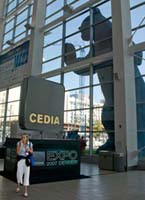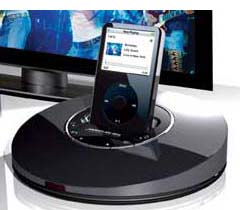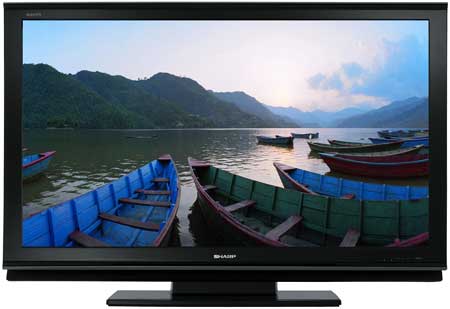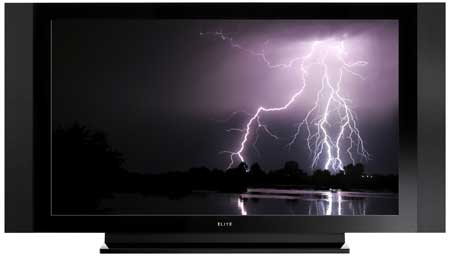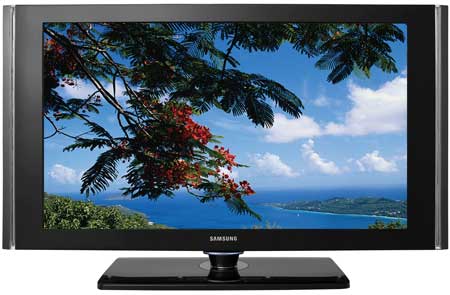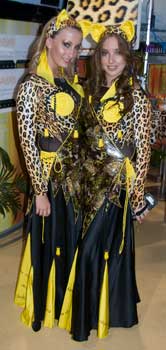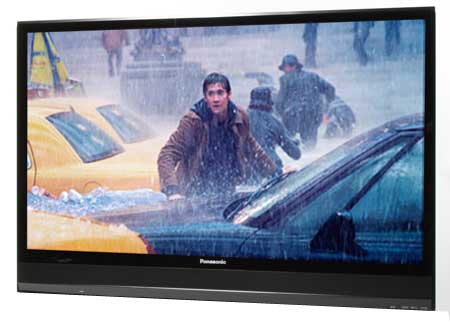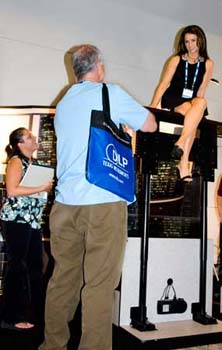
|
|
 |

|


Dick De Jong Molly Dinkins September 10, 2007 HDTV Solutions Another CEDIA conference just wrapped up in Denver. In our efforts to bring you the buzz on new HDTVs and related products, we were busy prowling the tradeshow aisles and taking booth appointments.
CEDIA, which stands for Custom Electronic Design & Installation Association, is an international trade association that consists of companies that specialize in designing and installing electronic systems for the home. At the top end of the economic food chain, these are the guys that put in those six figure home theaters in multimillion mansions. So it's not surprising to see a pair of $15,000 speakers that could pass for sculpture or a monolith sized $10,000 amplifier.
Then again, one of my favorite products was Meridian's iRIS, which is a little video iPod dock that will retail for about $375 when it's released in November. The unusual feature on the iRIS is that it upconverts low resolution iPod video to 1080p and outputs it through HDMI. Of course, our main focus was on HDTVs and most of the major manufacturers had booths full of this season's harvest. Last year at CEDIA, 1080p was the hot selling point. Twelve months later and the 1080p Full HD market has matured rather quickly. Already, the product line of some vendors is almost completely 1080p. I still feel that you can find great picture quality and good bargains in many 720p HDTVs, but it's obvious that the production pendulum has definitely swung to 1080p. For me, Contrast took center stage at this CEDIA. Just a couple of years ago, if an HDTV had a 1000:1 Contrast Ratio it would be at the top of its class, especially for LCDs. Plasmas always seemed to maintain an edge with Contrasts up to 10,000:1.
This year, at Sharp's booth, they were showing off their new AQUOS LCD with a 15,000:1 Dynamic Contrast Ratio. And if you were wondering if you could really see a difference in picture quality, they had a side by side display with one of their 10,000:1 models. Assuming they had the same setup, you could definitely see the darker blacks and richer colors on the higher contrast TV.
Not to be out blacked, Pioneer is finally beginning to ship their new Kuro line of plasmas with up to a 20,000:1 Contrast Ratio. Pioneer has been tempting us with prototypes of these black beauties since CES in January. What I saw from the Kuros being displayed, the wait was worth it. To push the Contrast envelope further into the stratosphere, at the Texas Instruments DLP booth, they were showing a microdisplay HDTV prototype featuring their DarkChip 4. The sign above it proclaimed a 100,000:1 Contrast Ratio.
The reigning Contrast champion that I found was the Samsung 81 Series 1080p LCD HDTV. Employing their LED smart lighting technology, the 81 series achieves a dynamic contrast ratio of 500,000:1 - yes, a half a million - that Samsung admits, rather offhandedly, is "amongst the highest ever seen on a flat panel." For most of us, our poor human eyes will not be able to perceive the difference in Contrast at a certain point. I'm hearing that anything over 35,000 is beyond normal, non-bionic vision. Whatever that number is, there is a more important consideration in this game of Contrast one-upmanship. We have noticed that some of the high contrast images that we have seen displayed tend to look artificial. Perhaps it's because our eyes are not accustomed to such high contrast. No matter the reason, HDTV manufacturers need to balance their technical ability to increase contrast with their aesthetic responsibility to produce realistic, pleasing images. For me, the real judge of a TV is not numbers but picture quality. That holds true for Resolution as well as Contrast. If You Build It in 3D, They Will Come If the guy standing behind me at the TI DLP demonstration was any indication, then the Wow factor prize at CEDIA goes to the 3D capable DLP HDTVs. A number of different models dotted the floor including ones from Mitsubishi and Samsung.
When these microdisplay HDTVs are showing regular high def material, they look like any other TVs. But when you feed them 3D content, these 3D-Ready HDTV models display that telltale slightly unaligned stereo image. Instead of wearing those funky red and blue lensed glasses, you need the more high tech battery powered spectacles that directs one of the stereo images to each eye. The effect can be startling or gimmicky depending on the content and your predilection. The fellow behind me couldn't get enough and by the time the 3D clip of Star Wars was blasting laser shots across our visual field, he was sold. If you want to set up your own 3D experience home theater, let me fill you in on the current state of the technology. First, you will need one of the 3D enabled HDTVs. Remember, only certain DLP microdisplays will work. All of the new Samsung DLP HDTVs are 3D ready. Second, the special 3D glasses are required. Samsung says that they are preparing a $200 package that will include two wireless 3D glasses and the software to decode the 3D content. Which brings us to the third item, 3D material and the equipment to play it back, currently, there are no standalone 3D ready DVD players. Right now, your only option is a PC with a DVD player to decode and output the 3D signal. Of course, the marketplace is not flooded with 3D content, but if this technology gains critical mass, we should be awash in 3D games and movies. 1.3 and 120 These two popular numbers are popping up on many HDTV spec sheets lately.
HDMI 1.3 is the new standard for this high definition connection. Many new products like HDTVs, A/V receivers, and DVD players, (and the cables that connect them), are becoming 1.3 compatible. I'll write more about 1.3 in a separate article. For now, let me say that unless you are a cutting edge sort of guy, you don't really need to worry about 1.3. The other big buzz term you see in all these split-screen demonstrations is 120 Hz. I also plan to write in greater detail about 120 Hz. Basically most HDTVs display 60 frames per second, or in other terms, 60 Hz. Many TV manufacturers are now producing select models that play 120 frames per second. The theory is that content with a lot of motion in a shot will look smoother at 120 Hz. And indeed, with some of these side by side demos, if you look closely at certain quick moving camera pans or tilts, you may notice a difference between the 60 HZ side and the 120 Hz. If you are particularly sensitive to this juddering effect, then you should check out 120 Hz TVs. LIFI
We are not big proponents of touting new display technologies before they are available in the marketplace. Why daze and confuse you with products that you can't buy? But we did see an honest-to-gosh real HDTV that uses a new light source for LCD rear projection displays.
Panasonic announced that they were shipping their LCZ and LCX series of rear projection LCDs that employ a LIFI lamp source instead of HID (High Intensity Discharge) bulbs. According to Panasonic, "The light source in the Panasonic LIFI HDTV does not use electrodes, resulting in more stable performance and a considerably longer lifespan. Additionally, Panasonic's LIFI technology projects a wide variety and spectrum of light, allowing for the most radiant reds, greens and natural skin tones." We've learned never to try to judge picture quality from a display at a tradeshow booth, so we will reserve our opinion about LIFIs until we can see one in our testing facility. But if the bulbs truly do have a longer life span over HIDs, then that will definitely be an improvement that may extend the viability of rear screen projectors in an increasingly fierce marketplace dominated by LCD and plasma flat panels. Stay tuned as we are beginning to receive many of these new units in for review. |
Bookmark:
![]() del.icio.us
del.icio.us
![]() Reddit
Reddit
![]() Google
Google
| Send this Page | Print this Page | Report Errors |


